Leadership Styles Across Industries
VerifiedAdded on 2020/03/13
|12
|2823
|45
AI Summary
This assignment delves into a comparative analysis of leadership styles exhibited by two prominent figures: Jawaharlal Nehru, the first Prime Minister of India, and Alan Joyce, CEO of Qantas Airways. It explores how their respective approaches shaped outcomes in vastly different domains – politics and business. The analysis examines both successes and failures, highlighting the unique challenges and opportunities they faced.
Contribute Materials
Your contribution can guide someone’s learning journey. Share your
documents today.
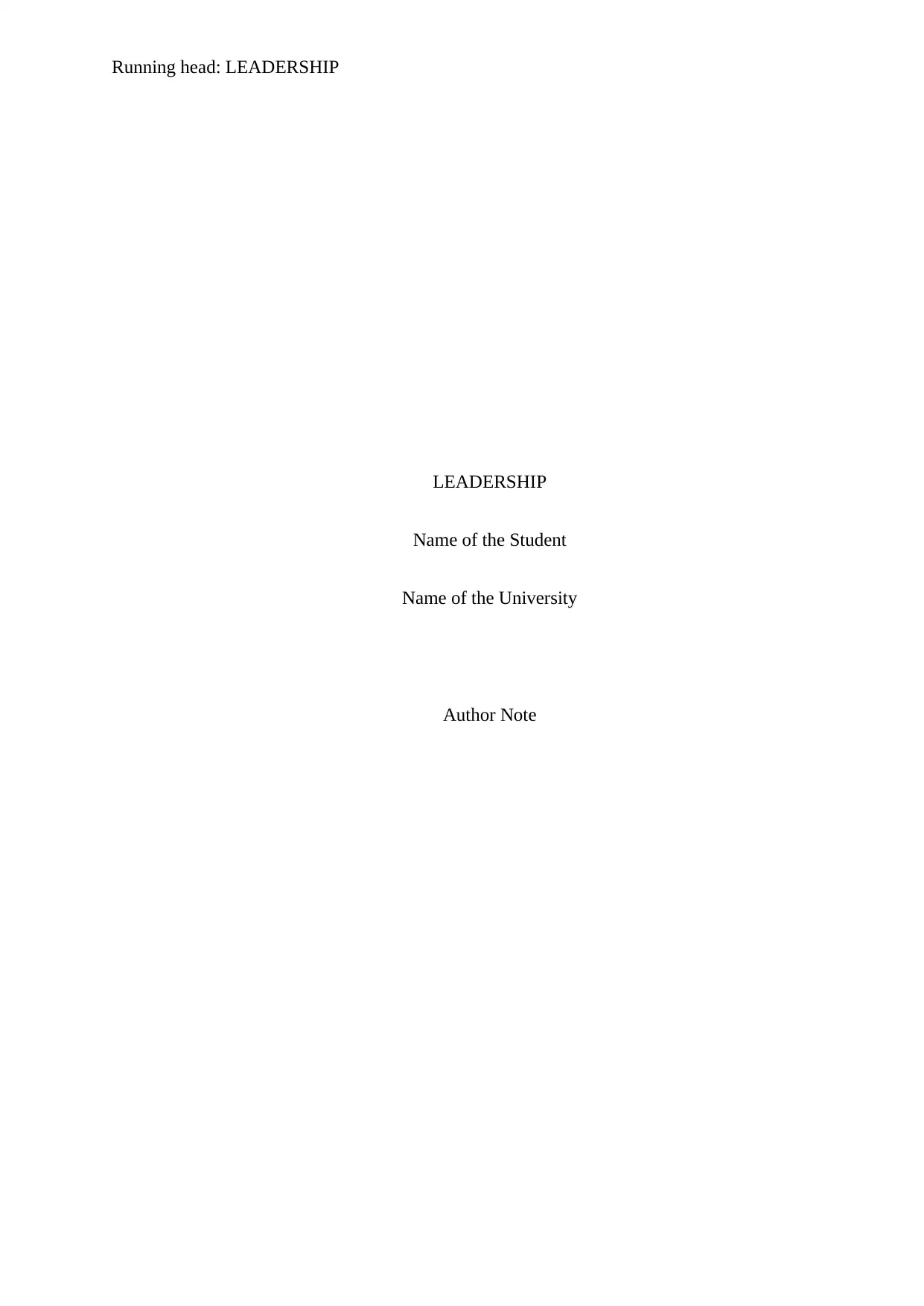
Running head: LEADERSHIP
LEADERSHIP
Name of the Student
Name of the University
Author Note
LEADERSHIP
Name of the Student
Name of the University
Author Note
Secure Best Marks with AI Grader
Need help grading? Try our AI Grader for instant feedback on your assignments.
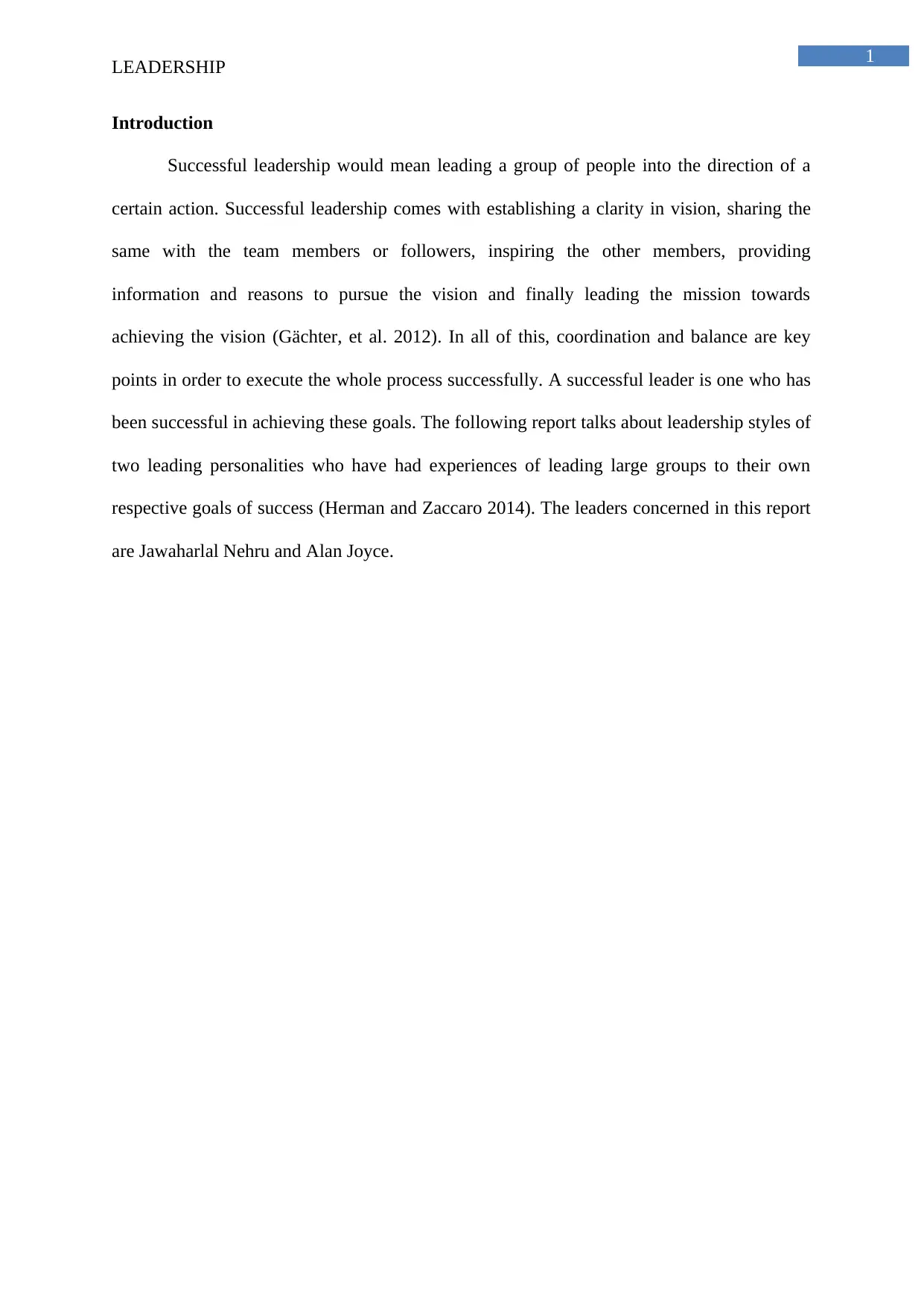
1
LEADERSHIP
Introduction
Successful leadership would mean leading a group of people into the direction of a
certain action. Successful leadership comes with establishing a clarity in vision, sharing the
same with the team members or followers, inspiring the other members, providing
information and reasons to pursue the vision and finally leading the mission towards
achieving the vision (Gächter, et al. 2012). In all of this, coordination and balance are key
points in order to execute the whole process successfully. A successful leader is one who has
been successful in achieving these goals. The following report talks about leadership styles of
two leading personalities who have had experiences of leading large groups to their own
respective goals of success (Herman and Zaccaro 2014). The leaders concerned in this report
are Jawaharlal Nehru and Alan Joyce.
LEADERSHIP
Introduction
Successful leadership would mean leading a group of people into the direction of a
certain action. Successful leadership comes with establishing a clarity in vision, sharing the
same with the team members or followers, inspiring the other members, providing
information and reasons to pursue the vision and finally leading the mission towards
achieving the vision (Gächter, et al. 2012). In all of this, coordination and balance are key
points in order to execute the whole process successfully. A successful leader is one who has
been successful in achieving these goals. The following report talks about leadership styles of
two leading personalities who have had experiences of leading large groups to their own
respective goals of success (Herman and Zaccaro 2014). The leaders concerned in this report
are Jawaharlal Nehru and Alan Joyce.
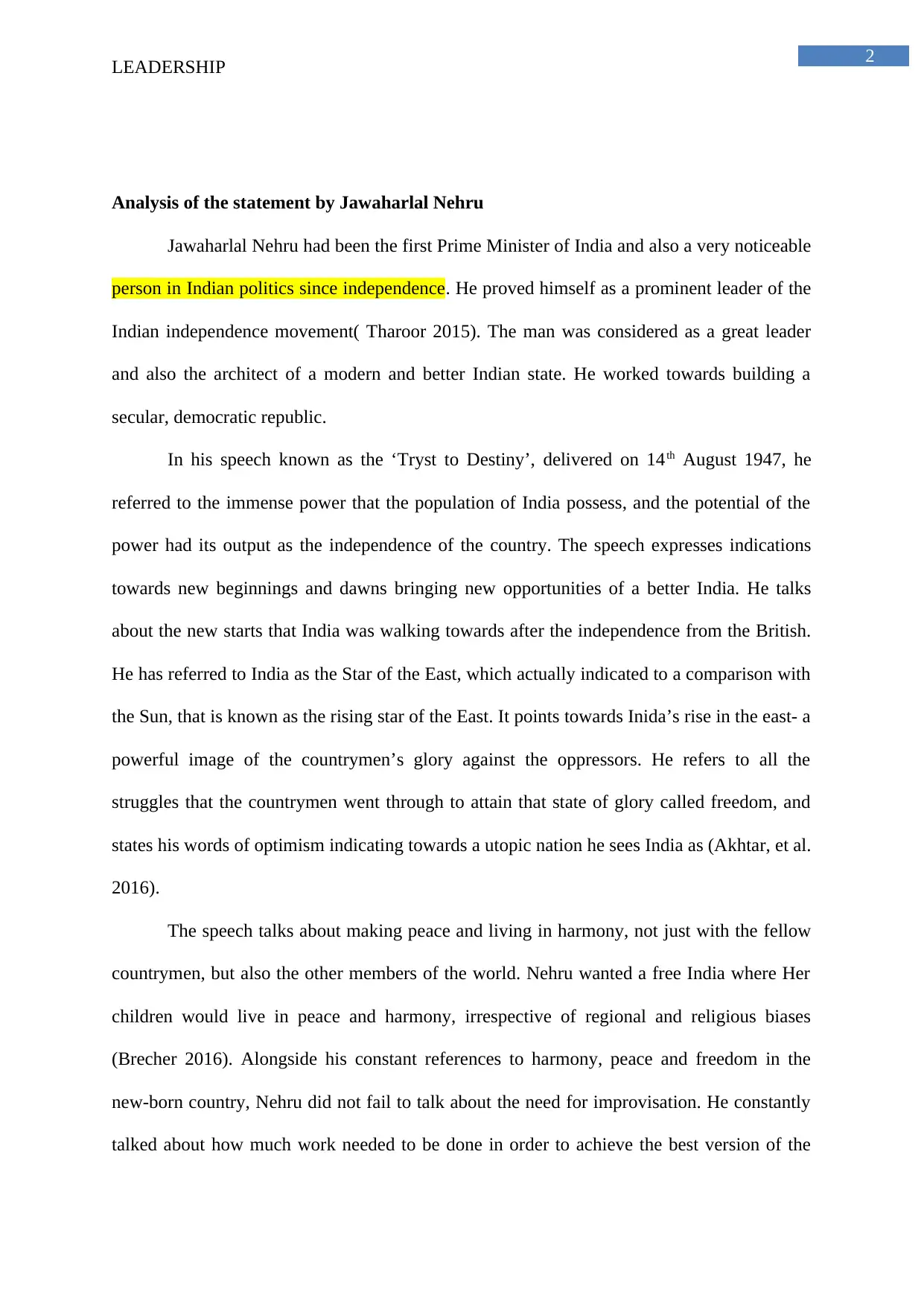
2
LEADERSHIP
Analysis of the statement by Jawaharlal Nehru
Jawaharlal Nehru had been the first Prime Minister of India and also a very noticeable
person in Indian politics since independence. He proved himself as a prominent leader of the
Indian independence movement( Tharoor 2015). The man was considered as a great leader
and also the architect of a modern and better Indian state. He worked towards building a
secular, democratic republic.
In his speech known as the ‘Tryst to Destiny’, delivered on 14th August 1947, he
referred to the immense power that the population of India possess, and the potential of the
power had its output as the independence of the country. The speech expresses indications
towards new beginnings and dawns bringing new opportunities of a better India. He talks
about the new starts that India was walking towards after the independence from the British.
He has referred to India as the Star of the East, which actually indicated to a comparison with
the Sun, that is known as the rising star of the East. It points towards Inida’s rise in the east- a
powerful image of the countrymen’s glory against the oppressors. He refers to all the
struggles that the countrymen went through to attain that state of glory called freedom, and
states his words of optimism indicating towards a utopic nation he sees India as (Akhtar, et al.
2016).
The speech talks about making peace and living in harmony, not just with the fellow
countrymen, but also the other members of the world. Nehru wanted a free India where Her
children would live in peace and harmony, irrespective of regional and religious biases
(Brecher 2016). Alongside his constant references to harmony, peace and freedom in the
new-born country, Nehru did not fail to talk about the need for improvisation. He constantly
talked about how much work needed to be done in order to achieve the best version of the
LEADERSHIP
Analysis of the statement by Jawaharlal Nehru
Jawaharlal Nehru had been the first Prime Minister of India and also a very noticeable
person in Indian politics since independence. He proved himself as a prominent leader of the
Indian independence movement( Tharoor 2015). The man was considered as a great leader
and also the architect of a modern and better Indian state. He worked towards building a
secular, democratic republic.
In his speech known as the ‘Tryst to Destiny’, delivered on 14th August 1947, he
referred to the immense power that the population of India possess, and the potential of the
power had its output as the independence of the country. The speech expresses indications
towards new beginnings and dawns bringing new opportunities of a better India. He talks
about the new starts that India was walking towards after the independence from the British.
He has referred to India as the Star of the East, which actually indicated to a comparison with
the Sun, that is known as the rising star of the East. It points towards Inida’s rise in the east- a
powerful image of the countrymen’s glory against the oppressors. He refers to all the
struggles that the countrymen went through to attain that state of glory called freedom, and
states his words of optimism indicating towards a utopic nation he sees India as (Akhtar, et al.
2016).
The speech talks about making peace and living in harmony, not just with the fellow
countrymen, but also the other members of the world. Nehru wanted a free India where Her
children would live in peace and harmony, irrespective of regional and religious biases
(Brecher 2016). Alongside his constant references to harmony, peace and freedom in the
new-born country, Nehru did not fail to talk about the need for improvisation. He constantly
talked about how much work needed to be done in order to achieve the best version of the
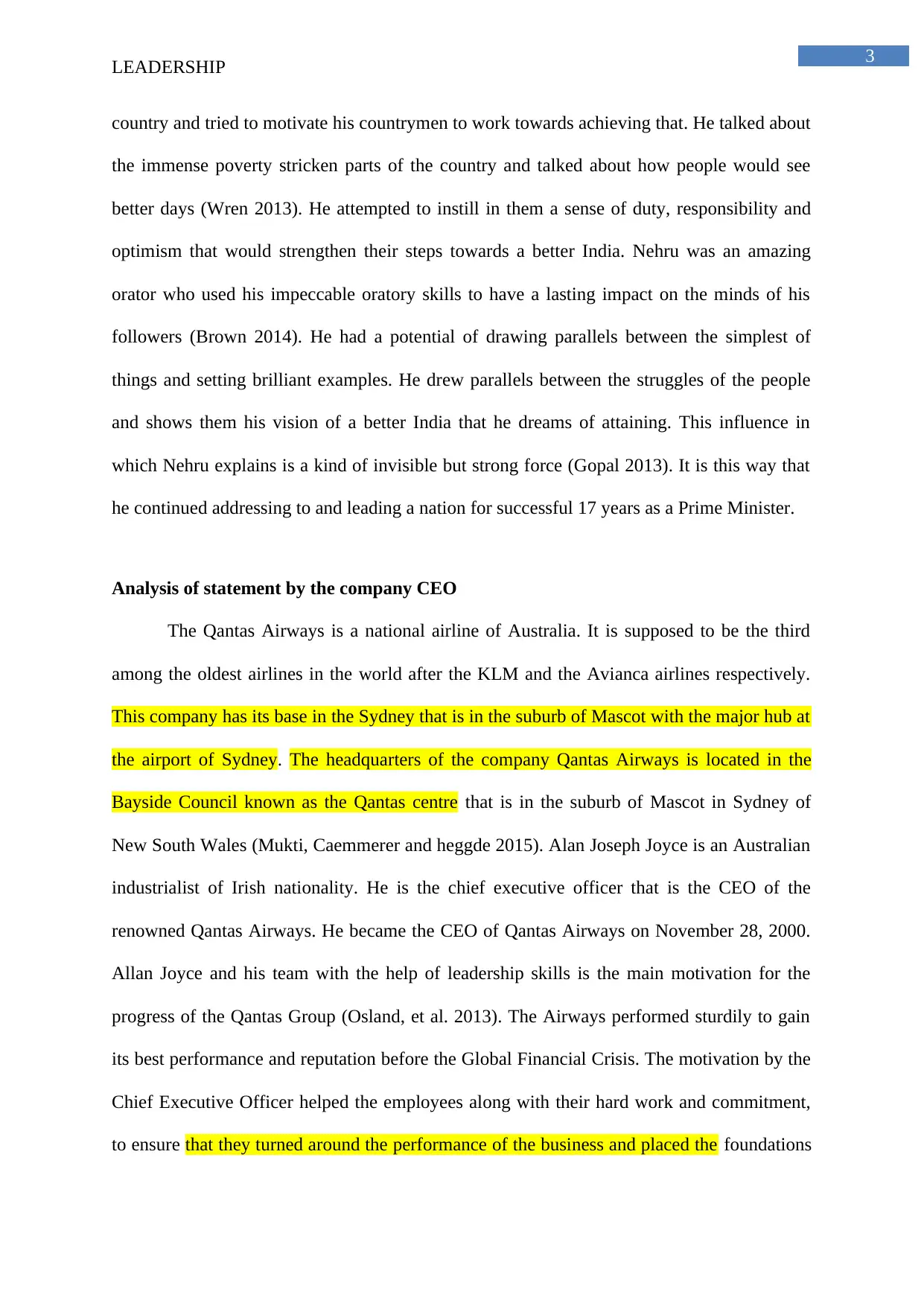
3
LEADERSHIP
country and tried to motivate his countrymen to work towards achieving that. He talked about
the immense poverty stricken parts of the country and talked about how people would see
better days (Wren 2013). He attempted to instill in them a sense of duty, responsibility and
optimism that would strengthen their steps towards a better India. Nehru was an amazing
orator who used his impeccable oratory skills to have a lasting impact on the minds of his
followers (Brown 2014). He had a potential of drawing parallels between the simplest of
things and setting brilliant examples. He drew parallels between the struggles of the people
and shows them his vision of a better India that he dreams of attaining. This influence in
which Nehru explains is a kind of invisible but strong force (Gopal 2013). It is this way that
he continued addressing to and leading a nation for successful 17 years as a Prime Minister.
Analysis of statement by the company CEO
The Qantas Airways is a national airline of Australia. It is supposed to be the third
among the oldest airlines in the world after the KLM and the Avianca airlines respectively.
This company has its base in the Sydney that is in the suburb of Mascot with the major hub at
the airport of Sydney. The headquarters of the company Qantas Airways is located in the
Bayside Council known as the Qantas centre that is in the suburb of Mascot in Sydney of
New South Wales (Mukti, Caemmerer and heggde 2015). Alan Joseph Joyce is an Australian
industrialist of Irish nationality. He is the chief executive officer that is the CEO of the
renowned Qantas Airways. He became the CEO of Qantas Airways on November 28, 2000.
Allan Joyce and his team with the help of leadership skills is the main motivation for the
progress of the Qantas Group (Osland, et al. 2013). The Airways performed sturdily to gain
its best performance and reputation before the Global Financial Crisis. The motivation by the
Chief Executive Officer helped the employees along with their hard work and commitment,
to ensure that they turned around the performance of the business and placed the foundations
LEADERSHIP
country and tried to motivate his countrymen to work towards achieving that. He talked about
the immense poverty stricken parts of the country and talked about how people would see
better days (Wren 2013). He attempted to instill in them a sense of duty, responsibility and
optimism that would strengthen their steps towards a better India. Nehru was an amazing
orator who used his impeccable oratory skills to have a lasting impact on the minds of his
followers (Brown 2014). He had a potential of drawing parallels between the simplest of
things and setting brilliant examples. He drew parallels between the struggles of the people
and shows them his vision of a better India that he dreams of attaining. This influence in
which Nehru explains is a kind of invisible but strong force (Gopal 2013). It is this way that
he continued addressing to and leading a nation for successful 17 years as a Prime Minister.
Analysis of statement by the company CEO
The Qantas Airways is a national airline of Australia. It is supposed to be the third
among the oldest airlines in the world after the KLM and the Avianca airlines respectively.
This company has its base in the Sydney that is in the suburb of Mascot with the major hub at
the airport of Sydney. The headquarters of the company Qantas Airways is located in the
Bayside Council known as the Qantas centre that is in the suburb of Mascot in Sydney of
New South Wales (Mukti, Caemmerer and heggde 2015). Alan Joseph Joyce is an Australian
industrialist of Irish nationality. He is the chief executive officer that is the CEO of the
renowned Qantas Airways. He became the CEO of Qantas Airways on November 28, 2000.
Allan Joyce and his team with the help of leadership skills is the main motivation for the
progress of the Qantas Group (Osland, et al. 2013). The Airways performed sturdily to gain
its best performance and reputation before the Global Financial Crisis. The motivation by the
Chief Executive Officer helped the employees along with their hard work and commitment,
to ensure that they turned around the performance of the business and placed the foundations
Secure Best Marks with AI Grader
Need help grading? Try our AI Grader for instant feedback on your assignments.
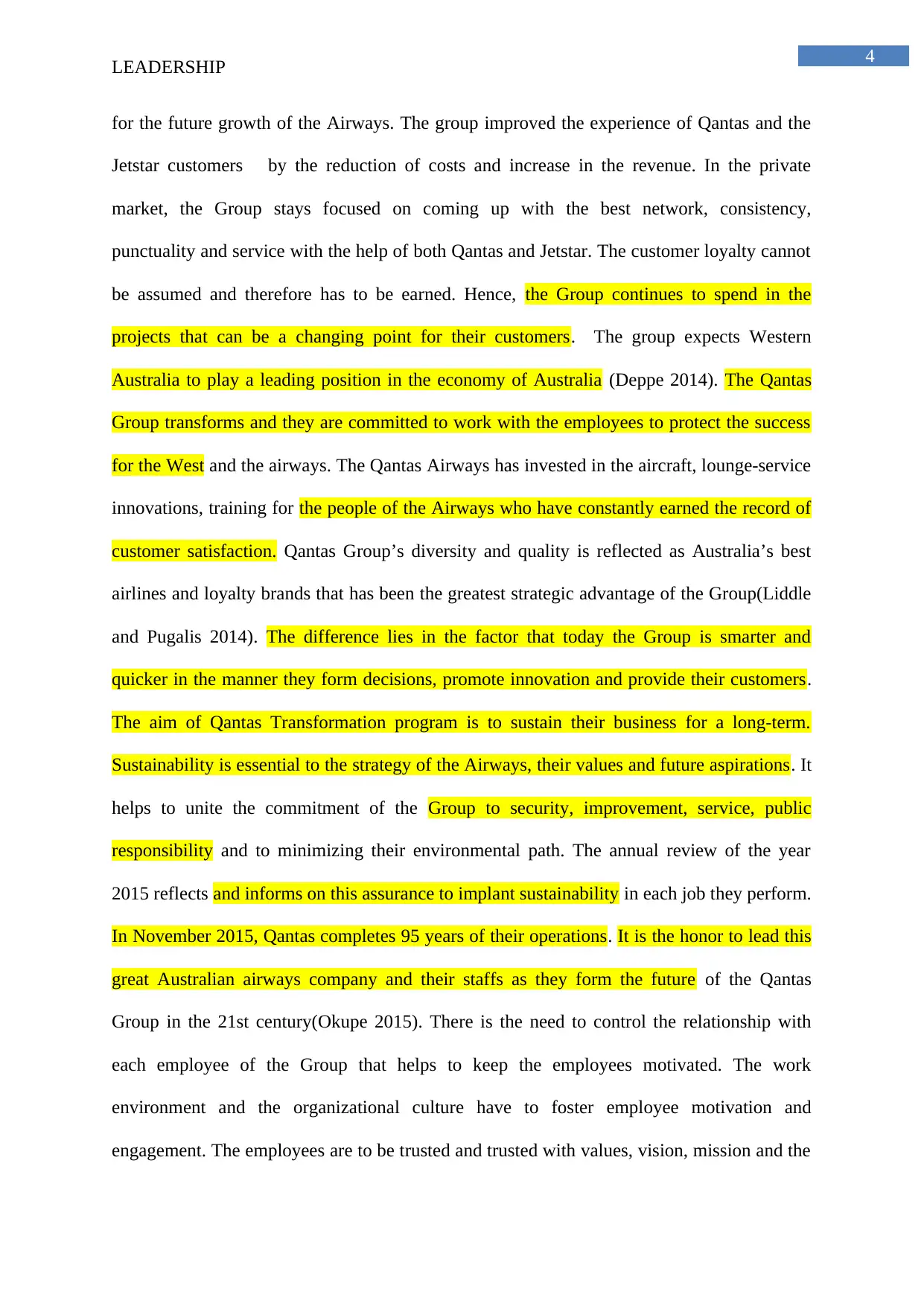
4
LEADERSHIP
for the future growth of the Airways. The group improved the experience of Qantas and the
Jetstar customers by the reduction of costs and increase in the revenue. In the private
market, the Group stays focused on coming up with the best network, consistency,
punctuality and service with the help of both Qantas and Jetstar. The customer loyalty cannot
be assumed and therefore has to be earned. Hence, the Group continues to spend in the
projects that can be a changing point for their customers. The group expects Western
Australia to play a leading position in the economy of Australia (Deppe 2014). The Qantas
Group transforms and they are committed to work with the employees to protect the success
for the West and the airways. The Qantas Airways has invested in the aircraft, lounge-service
innovations, training for the people of the Airways who have constantly earned the record of
customer satisfaction. Qantas Group’s diversity and quality is reflected as Australia’s best
airlines and loyalty brands that has been the greatest strategic advantage of the Group(Liddle
and Pugalis 2014). The difference lies in the factor that today the Group is smarter and
quicker in the manner they form decisions, promote innovation and provide their customers.
The aim of Qantas Transformation program is to sustain their business for a long-term.
Sustainability is essential to the strategy of the Airways, their values and future aspirations. It
helps to unite the commitment of the Group to security, improvement, service, public
responsibility and to minimizing their environmental path. The annual review of the year
2015 reflects and informs on this assurance to implant sustainability in each job they perform.
In November 2015, Qantas completes 95 years of their operations. It is the honor to lead this
great Australian airways company and their staffs as they form the future of the Qantas
Group in the 21st century(Okupe 2015). There is the need to control the relationship with
each employee of the Group that helps to keep the employees motivated. The work
environment and the organizational culture have to foster employee motivation and
engagement. The employees are to be trusted and trusted with values, vision, mission and the
LEADERSHIP
for the future growth of the Airways. The group improved the experience of Qantas and the
Jetstar customers by the reduction of costs and increase in the revenue. In the private
market, the Group stays focused on coming up with the best network, consistency,
punctuality and service with the help of both Qantas and Jetstar. The customer loyalty cannot
be assumed and therefore has to be earned. Hence, the Group continues to spend in the
projects that can be a changing point for their customers. The group expects Western
Australia to play a leading position in the economy of Australia (Deppe 2014). The Qantas
Group transforms and they are committed to work with the employees to protect the success
for the West and the airways. The Qantas Airways has invested in the aircraft, lounge-service
innovations, training for the people of the Airways who have constantly earned the record of
customer satisfaction. Qantas Group’s diversity and quality is reflected as Australia’s best
airlines and loyalty brands that has been the greatest strategic advantage of the Group(Liddle
and Pugalis 2014). The difference lies in the factor that today the Group is smarter and
quicker in the manner they form decisions, promote innovation and provide their customers.
The aim of Qantas Transformation program is to sustain their business for a long-term.
Sustainability is essential to the strategy of the Airways, their values and future aspirations. It
helps to unite the commitment of the Group to security, improvement, service, public
responsibility and to minimizing their environmental path. The annual review of the year
2015 reflects and informs on this assurance to implant sustainability in each job they perform.
In November 2015, Qantas completes 95 years of their operations. It is the honor to lead this
great Australian airways company and their staffs as they form the future of the Qantas
Group in the 21st century(Okupe 2015). There is the need to control the relationship with
each employee of the Group that helps to keep the employees motivated. The work
environment and the organizational culture have to foster employee motivation and
engagement. The employees are to be trusted and trusted with values, vision, mission and the
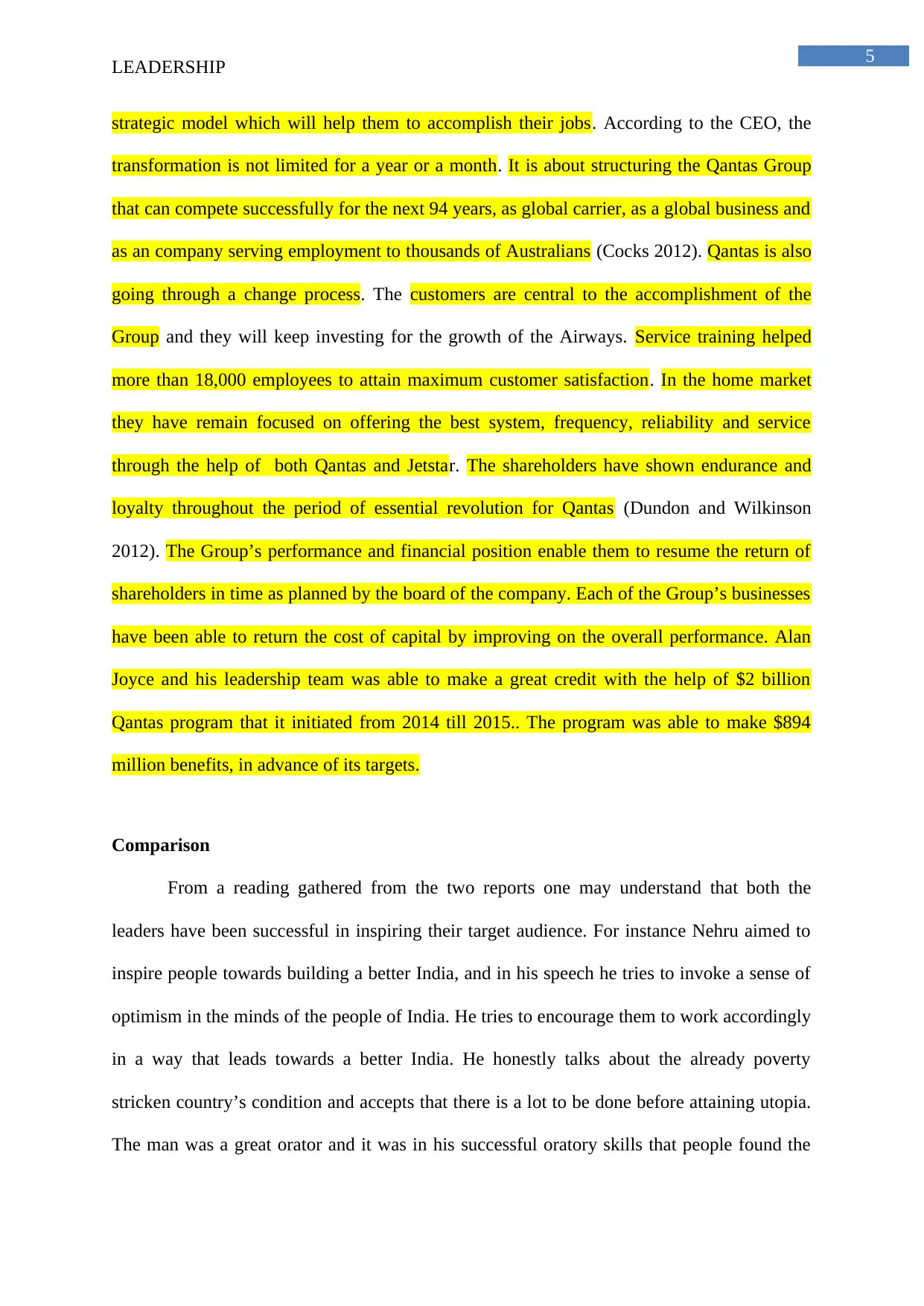
5
LEADERSHIP
strategic model which will help them to accomplish their jobs. According to the CEO, the
transformation is not limited for a year or a month. It is about structuring the Qantas Group
that can compete successfully for the next 94 years, as global carrier, as a global business and
as an company serving employment to thousands of Australians (Cocks 2012). Qantas is also
going through a change process. The customers are central to the accomplishment of the
Group and they will keep investing for the growth of the Airways. Service training helped
more than 18,000 employees to attain maximum customer satisfaction. In the home market
they have remain focused on offering the best system, frequency, reliability and service
through the help of both Qantas and Jetstar. The shareholders have shown endurance and
loyalty throughout the period of essential revolution for Qantas (Dundon and Wilkinson
2012). The Group’s performance and financial position enable them to resume the return of
shareholders in time as planned by the board of the company. Each of the Group’s businesses
have been able to return the cost of capital by improving on the overall performance. Alan
Joyce and his leadership team was able to make a great credit with the help of $2 billion
Qantas program that it initiated from 2014 till 2015.. The program was able to make $894
million benefits, in advance of its targets.
Comparison
From a reading gathered from the two reports one may understand that both the
leaders have been successful in inspiring their target audience. For instance Nehru aimed to
inspire people towards building a better India, and in his speech he tries to invoke a sense of
optimism in the minds of the people of India. He tries to encourage them to work accordingly
in a way that leads towards a better India. He honestly talks about the already poverty
stricken country’s condition and accepts that there is a lot to be done before attaining utopia.
The man was a great orator and it was in his successful oratory skills that people found the
LEADERSHIP
strategic model which will help them to accomplish their jobs. According to the CEO, the
transformation is not limited for a year or a month. It is about structuring the Qantas Group
that can compete successfully for the next 94 years, as global carrier, as a global business and
as an company serving employment to thousands of Australians (Cocks 2012). Qantas is also
going through a change process. The customers are central to the accomplishment of the
Group and they will keep investing for the growth of the Airways. Service training helped
more than 18,000 employees to attain maximum customer satisfaction. In the home market
they have remain focused on offering the best system, frequency, reliability and service
through the help of both Qantas and Jetstar. The shareholders have shown endurance and
loyalty throughout the period of essential revolution for Qantas (Dundon and Wilkinson
2012). The Group’s performance and financial position enable them to resume the return of
shareholders in time as planned by the board of the company. Each of the Group’s businesses
have been able to return the cost of capital by improving on the overall performance. Alan
Joyce and his leadership team was able to make a great credit with the help of $2 billion
Qantas program that it initiated from 2014 till 2015.. The program was able to make $894
million benefits, in advance of its targets.
Comparison
From a reading gathered from the two reports one may understand that both the
leaders have been successful in inspiring their target audience. For instance Nehru aimed to
inspire people towards building a better India, and in his speech he tries to invoke a sense of
optimism in the minds of the people of India. He tries to encourage them to work accordingly
in a way that leads towards a better India. He honestly talks about the already poverty
stricken country’s condition and accepts that there is a lot to be done before attaining utopia.
The man was a great orator and it was in his successful oratory skills that people found the
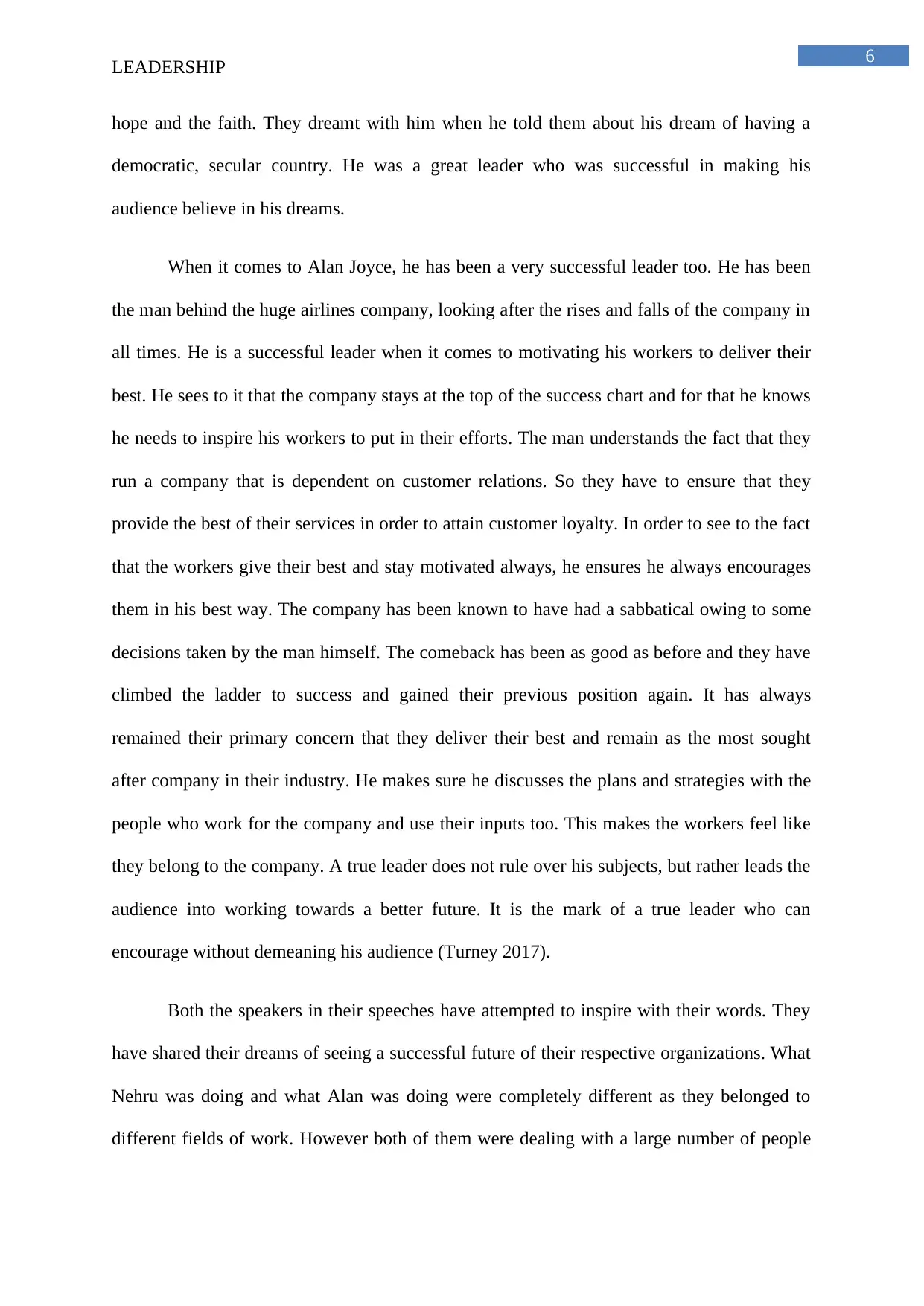
6
LEADERSHIP
hope and the faith. They dreamt with him when he told them about his dream of having a
democratic, secular country. He was a great leader who was successful in making his
audience believe in his dreams.
When it comes to Alan Joyce, he has been a very successful leader too. He has been
the man behind the huge airlines company, looking after the rises and falls of the company in
all times. He is a successful leader when it comes to motivating his workers to deliver their
best. He sees to it that the company stays at the top of the success chart and for that he knows
he needs to inspire his workers to put in their efforts. The man understands the fact that they
run a company that is dependent on customer relations. So they have to ensure that they
provide the best of their services in order to attain customer loyalty. In order to see to the fact
that the workers give their best and stay motivated always, he ensures he always encourages
them in his best way. The company has been known to have had a sabbatical owing to some
decisions taken by the man himself. The comeback has been as good as before and they have
climbed the ladder to success and gained their previous position again. It has always
remained their primary concern that they deliver their best and remain as the most sought
after company in their industry. He makes sure he discusses the plans and strategies with the
people who work for the company and use their inputs too. This makes the workers feel like
they belong to the company. A true leader does not rule over his subjects, but rather leads the
audience into working towards a better future. It is the mark of a true leader who can
encourage without demeaning his audience (Turney 2017).
Both the speakers in their speeches have attempted to inspire with their words. They
have shared their dreams of seeing a successful future of their respective organizations. What
Nehru was doing and what Alan was doing were completely different as they belonged to
different fields of work. However both of them were dealing with a large number of people
LEADERSHIP
hope and the faith. They dreamt with him when he told them about his dream of having a
democratic, secular country. He was a great leader who was successful in making his
audience believe in his dreams.
When it comes to Alan Joyce, he has been a very successful leader too. He has been
the man behind the huge airlines company, looking after the rises and falls of the company in
all times. He is a successful leader when it comes to motivating his workers to deliver their
best. He sees to it that the company stays at the top of the success chart and for that he knows
he needs to inspire his workers to put in their efforts. The man understands the fact that they
run a company that is dependent on customer relations. So they have to ensure that they
provide the best of their services in order to attain customer loyalty. In order to see to the fact
that the workers give their best and stay motivated always, he ensures he always encourages
them in his best way. The company has been known to have had a sabbatical owing to some
decisions taken by the man himself. The comeback has been as good as before and they have
climbed the ladder to success and gained their previous position again. It has always
remained their primary concern that they deliver their best and remain as the most sought
after company in their industry. He makes sure he discusses the plans and strategies with the
people who work for the company and use their inputs too. This makes the workers feel like
they belong to the company. A true leader does not rule over his subjects, but rather leads the
audience into working towards a better future. It is the mark of a true leader who can
encourage without demeaning his audience (Turney 2017).
Both the speakers in their speeches have attempted to inspire with their words. They
have shared their dreams of seeing a successful future of their respective organizations. What
Nehru was doing and what Alan was doing were completely different as they belonged to
different fields of work. However both of them were dealing with a large number of people
Paraphrase This Document
Need a fresh take? Get an instant paraphrase of this document with our AI Paraphraser

7
LEADERSHIP
who were under them or willing to follow them. But the one thing in both of them that has
been common is their zest to achieve the best for their people.
LEADERSHIP
who were under them or willing to follow them. But the one thing in both of them that has
been common is their zest to achieve the best for their people.
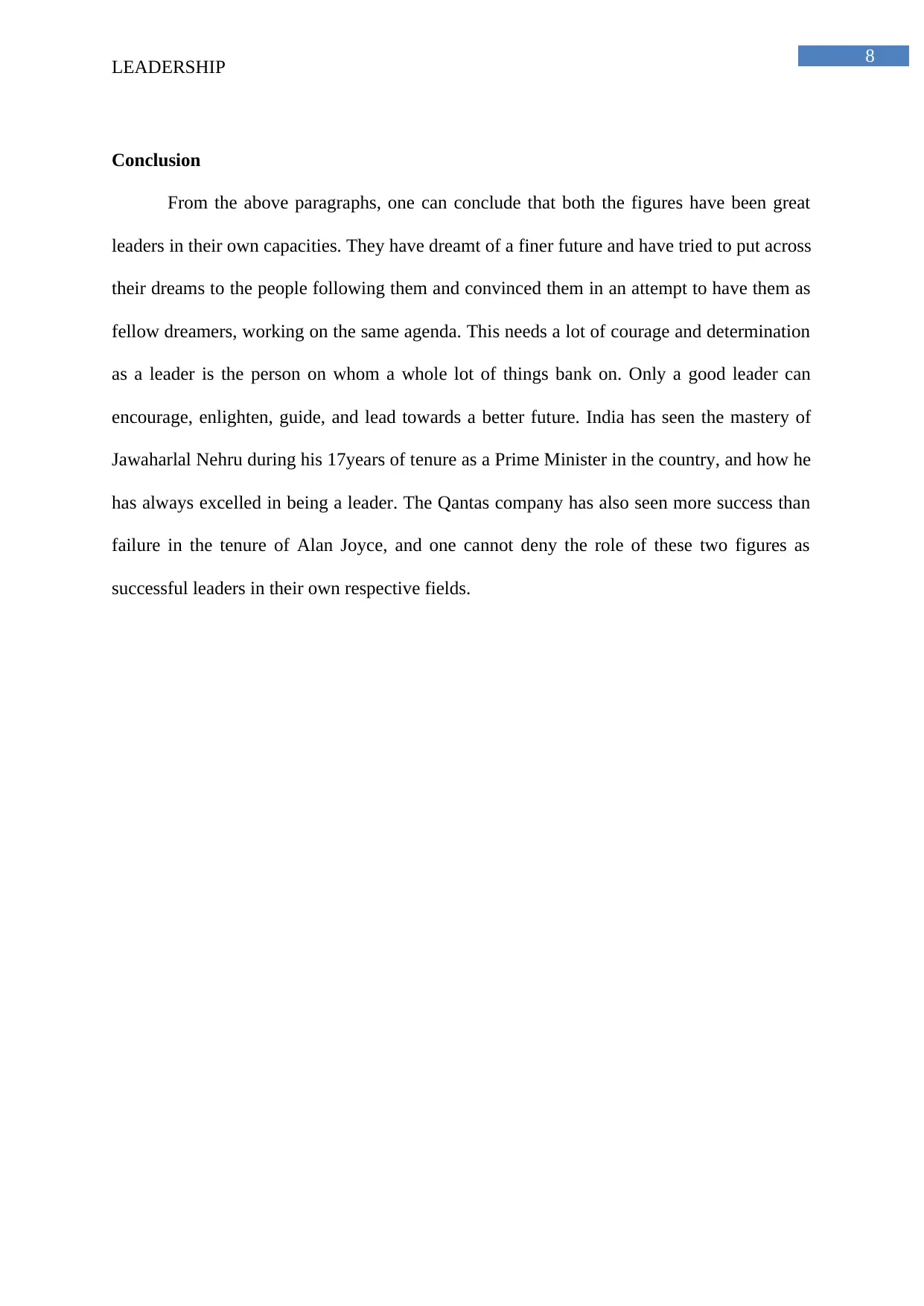
8
LEADERSHIP
Conclusion
From the above paragraphs, one can conclude that both the figures have been great
leaders in their own capacities. They have dreamt of a finer future and have tried to put across
their dreams to the people following them and convinced them in an attempt to have them as
fellow dreamers, working on the same agenda. This needs a lot of courage and determination
as a leader is the person on whom a whole lot of things bank on. Only a good leader can
encourage, enlighten, guide, and lead towards a better future. India has seen the mastery of
Jawaharlal Nehru during his 17years of tenure as a Prime Minister in the country, and how he
has always excelled in being a leader. The Qantas company has also seen more success than
failure in the tenure of Alan Joyce, and one cannot deny the role of these two figures as
successful leaders in their own respective fields.
LEADERSHIP
Conclusion
From the above paragraphs, one can conclude that both the figures have been great
leaders in their own capacities. They have dreamt of a finer future and have tried to put across
their dreams to the people following them and convinced them in an attempt to have them as
fellow dreamers, working on the same agenda. This needs a lot of courage and determination
as a leader is the person on whom a whole lot of things bank on. Only a good leader can
encourage, enlighten, guide, and lead towards a better future. India has seen the mastery of
Jawaharlal Nehru during his 17years of tenure as a Prime Minister in the country, and how he
has always excelled in being a leader. The Qantas company has also seen more success than
failure in the tenure of Alan Joyce, and one cannot deny the role of these two figures as
successful leaders in their own respective fields.
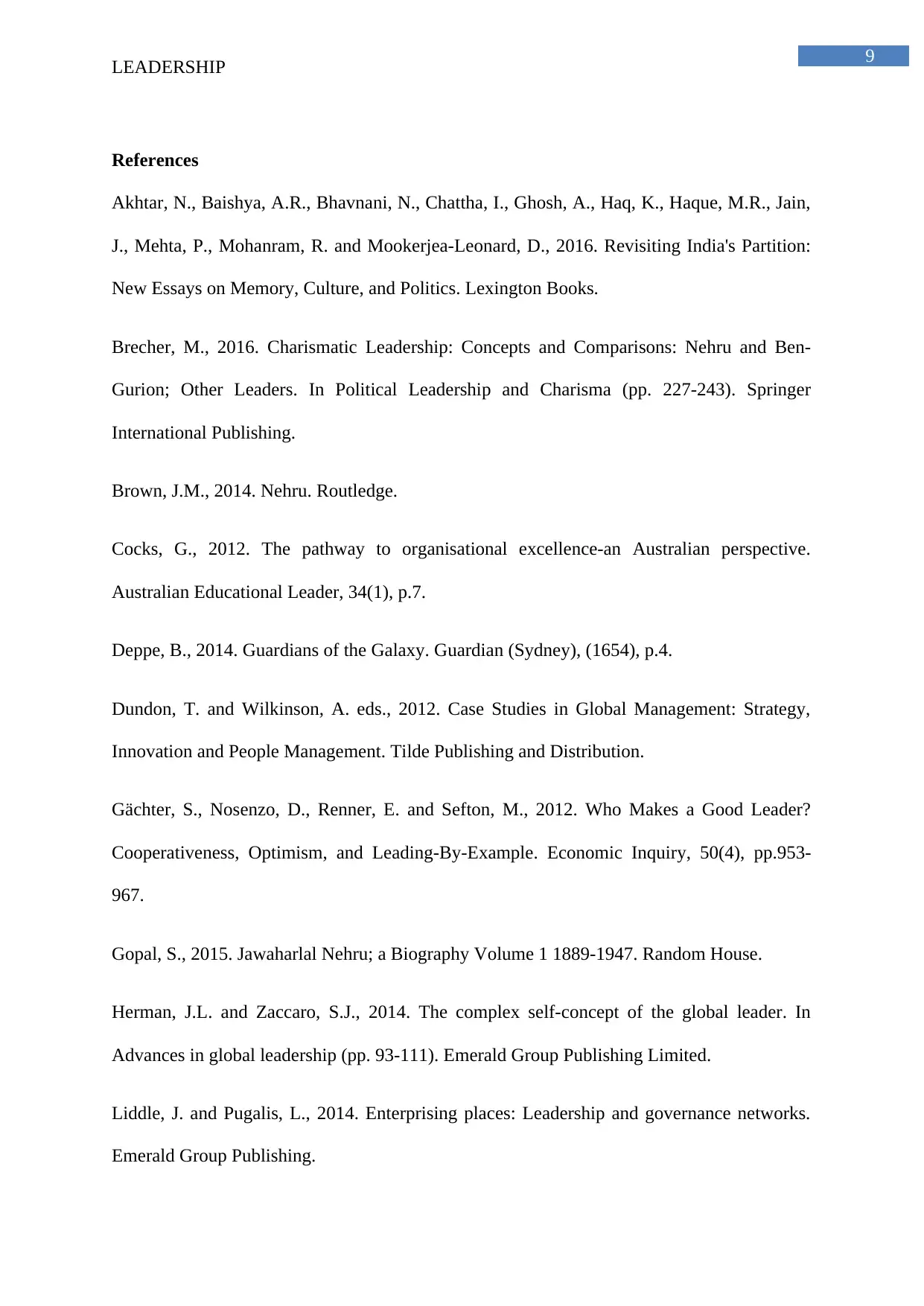
9
LEADERSHIP
References
Akhtar, N., Baishya, A.R., Bhavnani, N., Chattha, I., Ghosh, A., Haq, K., Haque, M.R., Jain,
J., Mehta, P., Mohanram, R. and Mookerjea-Leonard, D., 2016. Revisiting India's Partition:
New Essays on Memory, Culture, and Politics. Lexington Books.
Brecher, M., 2016. Charismatic Leadership: Concepts and Comparisons: Nehru and Ben-
Gurion; Other Leaders. In Political Leadership and Charisma (pp. 227-243). Springer
International Publishing.
Brown, J.M., 2014. Nehru. Routledge.
Cocks, G., 2012. The pathway to organisational excellence-an Australian perspective.
Australian Educational Leader, 34(1), p.7.
Deppe, B., 2014. Guardians of the Galaxy. Guardian (Sydney), (1654), p.4.
Dundon, T. and Wilkinson, A. eds., 2012. Case Studies in Global Management: Strategy,
Innovation and People Management. Tilde Publishing and Distribution.
Gächter, S., Nosenzo, D., Renner, E. and Sefton, M., 2012. Who Makes a Good Leader?
Cooperativeness, Optimism, and Leading‐By‐Example. Economic Inquiry, 50(4), pp.953-
967.
Gopal, S., 2015. Jawaharlal Nehru; a Biography Volume 1 1889-1947. Random House.
Herman, J.L. and Zaccaro, S.J., 2014. The complex self-concept of the global leader. In
Advances in global leadership (pp. 93-111). Emerald Group Publishing Limited.
Liddle, J. and Pugalis, L., 2014. Enterprising places: Leadership and governance networks.
Emerald Group Publishing.
LEADERSHIP
References
Akhtar, N., Baishya, A.R., Bhavnani, N., Chattha, I., Ghosh, A., Haq, K., Haque, M.R., Jain,
J., Mehta, P., Mohanram, R. and Mookerjea-Leonard, D., 2016. Revisiting India's Partition:
New Essays on Memory, Culture, and Politics. Lexington Books.
Brecher, M., 2016. Charismatic Leadership: Concepts and Comparisons: Nehru and Ben-
Gurion; Other Leaders. In Political Leadership and Charisma (pp. 227-243). Springer
International Publishing.
Brown, J.M., 2014. Nehru. Routledge.
Cocks, G., 2012. The pathway to organisational excellence-an Australian perspective.
Australian Educational Leader, 34(1), p.7.
Deppe, B., 2014. Guardians of the Galaxy. Guardian (Sydney), (1654), p.4.
Dundon, T. and Wilkinson, A. eds., 2012. Case Studies in Global Management: Strategy,
Innovation and People Management. Tilde Publishing and Distribution.
Gächter, S., Nosenzo, D., Renner, E. and Sefton, M., 2012. Who Makes a Good Leader?
Cooperativeness, Optimism, and Leading‐By‐Example. Economic Inquiry, 50(4), pp.953-
967.
Gopal, S., 2015. Jawaharlal Nehru; a Biography Volume 1 1889-1947. Random House.
Herman, J.L. and Zaccaro, S.J., 2014. The complex self-concept of the global leader. In
Advances in global leadership (pp. 93-111). Emerald Group Publishing Limited.
Liddle, J. and Pugalis, L., 2014. Enterprising places: Leadership and governance networks.
Emerald Group Publishing.
Secure Best Marks with AI Grader
Need help grading? Try our AI Grader for instant feedback on your assignments.
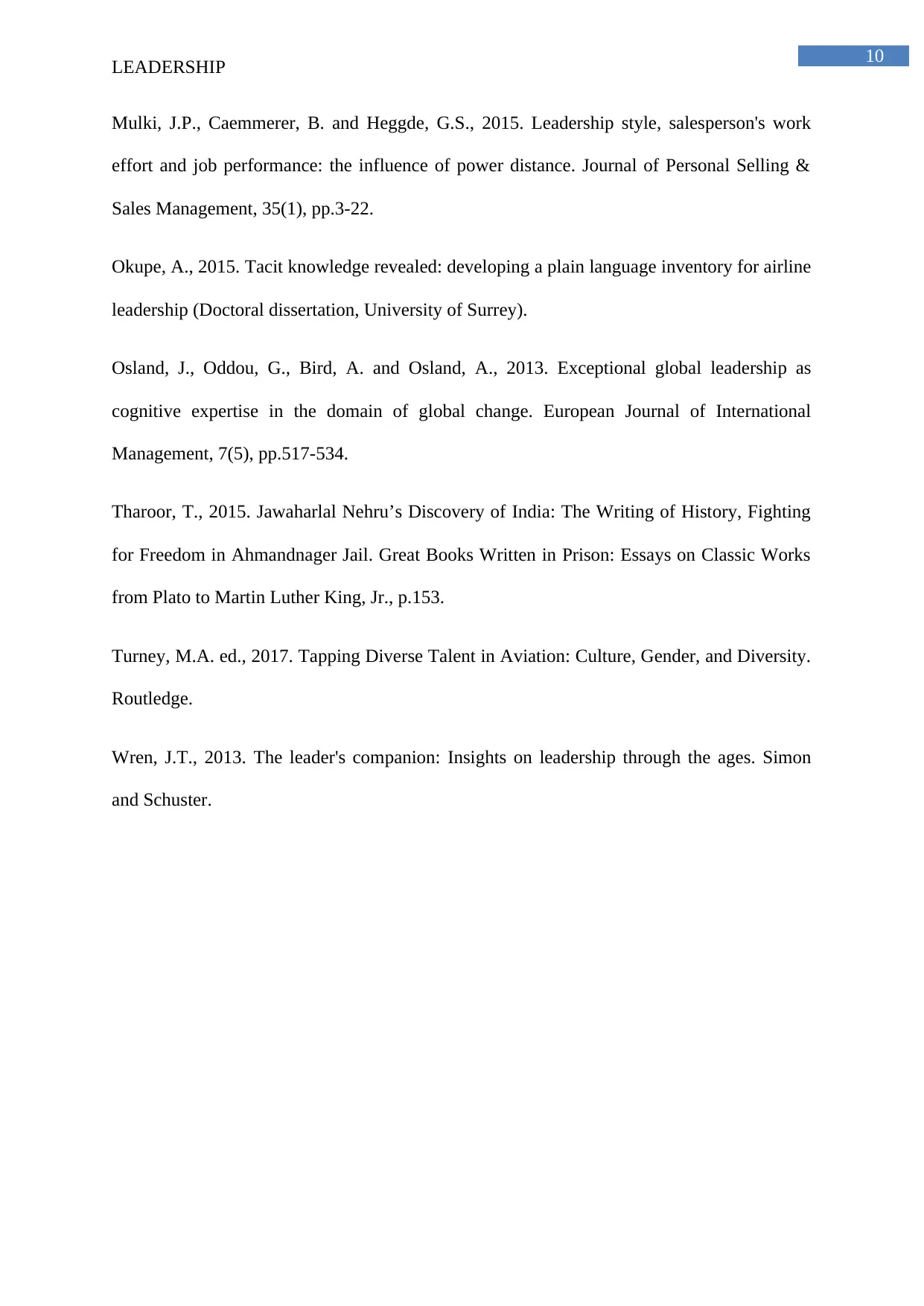
10
LEADERSHIP
Mulki, J.P., Caemmerer, B. and Heggde, G.S., 2015. Leadership style, salesperson's work
effort and job performance: the influence of power distance. Journal of Personal Selling &
Sales Management, 35(1), pp.3-22.
Okupe, A., 2015. Tacit knowledge revealed: developing a plain language inventory for airline
leadership (Doctoral dissertation, University of Surrey).
Osland, J., Oddou, G., Bird, A. and Osland, A., 2013. Exceptional global leadership as
cognitive expertise in the domain of global change. European Journal of International
Management, 7(5), pp.517-534.
Tharoor, T., 2015. Jawaharlal Nehru’s Discovery of India: The Writing of History, Fighting
for Freedom in Ahmandnager Jail. Great Books Written in Prison: Essays on Classic Works
from Plato to Martin Luther King, Jr., p.153.
Turney, M.A. ed., 2017. Tapping Diverse Talent in Aviation: Culture, Gender, and Diversity.
Routledge.
Wren, J.T., 2013. The leader's companion: Insights on leadership through the ages. Simon
and Schuster.
LEADERSHIP
Mulki, J.P., Caemmerer, B. and Heggde, G.S., 2015. Leadership style, salesperson's work
effort and job performance: the influence of power distance. Journal of Personal Selling &
Sales Management, 35(1), pp.3-22.
Okupe, A., 2015. Tacit knowledge revealed: developing a plain language inventory for airline
leadership (Doctoral dissertation, University of Surrey).
Osland, J., Oddou, G., Bird, A. and Osland, A., 2013. Exceptional global leadership as
cognitive expertise in the domain of global change. European Journal of International
Management, 7(5), pp.517-534.
Tharoor, T., 2015. Jawaharlal Nehru’s Discovery of India: The Writing of History, Fighting
for Freedom in Ahmandnager Jail. Great Books Written in Prison: Essays on Classic Works
from Plato to Martin Luther King, Jr., p.153.
Turney, M.A. ed., 2017. Tapping Diverse Talent in Aviation: Culture, Gender, and Diversity.
Routledge.
Wren, J.T., 2013. The leader's companion: Insights on leadership through the ages. Simon
and Schuster.

11
LEADERSHIP
LEADERSHIP
1 out of 12
Your All-in-One AI-Powered Toolkit for Academic Success.
+13062052269
info@desklib.com
Available 24*7 on WhatsApp / Email
![[object Object]](/_next/static/media/star-bottom.7253800d.svg)
Unlock your academic potential
© 2024 | Zucol Services PVT LTD | All rights reserved.


